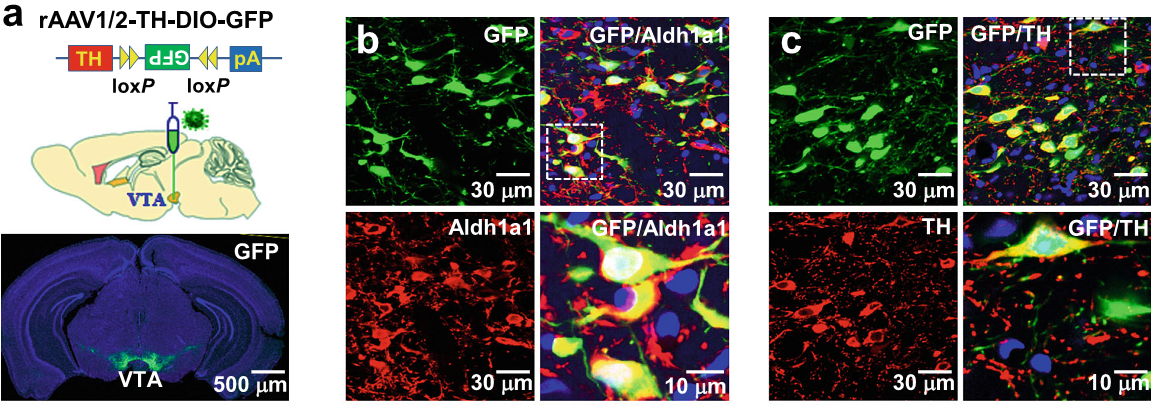AAVs and HSV used in this article was used to investigate synaptic transmission between Aldh1a1neurons and EGNIS. (From
BrainVTA)
The viruses used in this article from BrainVTA are in the table below
|
HSV |
H129ΔTK-FLP |
|
AAVs |
rAAV1/2-TH-DIO-Gi-ChR2tdT
rAAV1/2-TH-DIO-TK |
Xinyan Li, Wenting Chen, Xian Huang, Wei Jing, Tongmei Zhang, Quntao Yu, Hongyan Yu, Hao Li, Qing Tian, Yumei Ding, Youming Lu
Pub Date: 2021-10-26,
DOI: 10.1186/s13024-021-00494-9,
Email: [email protected]
Aldh1a1 neurons are a subtype of gamma-aminobutyric acid (GABA) inhibitory neurons that use Aldh1a1 rather than glutamate decarboxylase (GAD) as an enzyme for synthesizing GABA transmitters. However, the behaviors and circuits of this newly identified subtype of inhibitory interneurons remain unknown. We generated a mutant mouse line in which cyclization recombination enzyme (CRE) was expressed under the control of the Aldh1a1 promotor (Aldh1a1-CRE mice). Using this mutant strain of mice together with the heterozygous male Alzheimer’s disease (AD) related model mice (APPswe/PSEN1dE9, or AD mice) and a genetically modified retrograde and anterograde synaptic tracing strategy, we have studied a specific synaptic circuit of Aldh1a1 neurons with system-level function and disease progression in AD mice. We demonstrate that Aldh1a1 neurons encode delay of gratification that measures self-control skills in decision making by projecting inhibitory synapses directly onto excitatory glutamate neurons in the intermediate lateral septum (EGNIS) and receiving synaptic inputs from layer 5b pyramidal neurons in the medial prefrontal cortex (L5PN). L5PN → Aldh1a1 synaptic transmission undergoes long-term potentiation (LTP). Pathway specific inhibition by either genetic silencing presynaptic terminals or antagonizing postsynaptic receptors impairs delay of gratification, resulting in the impulsive behaviors. Further studies show that reconstitution of Aldh1a1-deficient neurons with the expression of exogenous Aldh1a1 (eAldh1a1) restores Aldh1a1 → EGNIS synaptic transmission and rescues the impulsive behaviors in AD mice. These results not only identify a specific function and circuit of Aldh1a1 neurons but also provide a cellular point of entry to an important but understudied synaptic mechanism for the induction of impulsive behaviors at an early stage of AD.
 Figure 1. Genetic mapping of Aldh1a1 neurons and their synaptic targets in adult mice.
Figure 1. Genetic mapping of Aldh1a1 neurons and their synaptic targets in adult mice.
In this study, the authors performed an integrative study using retrograde and anterograde synaptic tracing methods linking a specific synaptic and circuitry mechanism with the systems-level function of Aldh1a1 neurons. The finding of Aldh1a1neurons in the control of impulsive behaviors warrants a specific cellular target for the therapeutic intervention of value-directed decision making diseases such as AD.
BrainVTA offers viral vector construction & virus packaging services for AAV, LV, RABV, PRV, HSV and VSV that help researchers explore questions about genes, neurons, circuitry structure, function of brain network, mechanism and treatment of diseases.
If you have any needs, just email us at
[email protected].
